Luz en la luna
Luz en la luna
Fases de la luna
Eclipse lunar
modelos
Otra
Where does the moon get its light? / ¿De dónde saca la luna su luz?
the sun / el sol
What moon phase is this?
¿Qué fase lunar es esta?
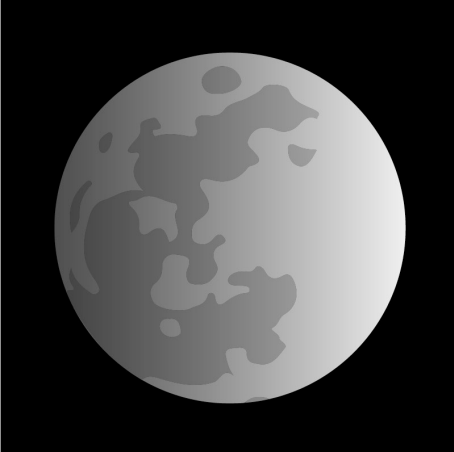
full moon / luna llena
What are 2 conditions that need to met in order for a lunar eclipse to occur?
¿Cuáles son las 2 condiciones que deben cumplirse para que ocurra un eclipse lunar?
1. There needs to be a full moon / Tiene que haber luna llena
2. The sun, Earth, and moon need to align / El sol, la tierra y la luna necesitan alinearse
Why is half the moon shaded and the other half light up in this top view model?
¿Por qué la mitad de la luna está sombreada y la otra mitad iluminada en este modelo de vista superior?
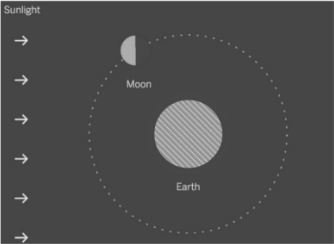
Because the diagram is showing that the half of the Moon that is facing the sun is lit by the sun and the other half is dark.
Porque el diagrama muestra que la mitad de la Luna que mira al sol está iluminada por el sol y la otra mitad está oscura.
Write or draw 1 thing you learned in this unit.
Escribe o dibuja 1 cosa que aprendiste en esta unidad.
Answers will vary
Las respuestas variarán
How does light from the Sun travel? / ¿Cómo viaja la luz del Sol?
Light from the sun travels in straight lines / La luz del sol viaja en línea recta
What moon phase is this? / ¿Qué fase lunar es esta?

new moon / luna nueva
Draw a top view diagram of a lunar eclipse. What moon phase is occurring?
Dibuja un diagrama de vista superior de un eclipse lunar. ¿Qué fase lunar está ocurriendo?
full moon / luna llena
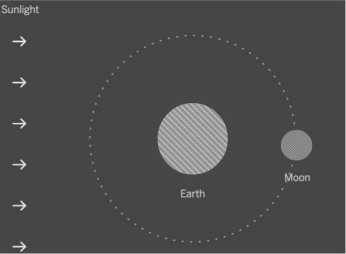
Why is there a dotted circle drawn in this diagram?
¿Por qué hay un círculo punteado dibujado en este diagrama?
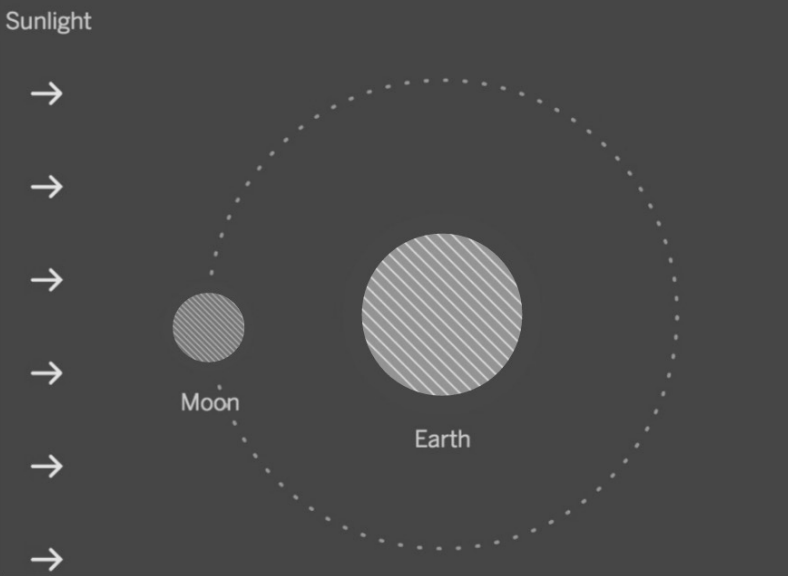
To show that the moon is always moving (orbiting) around Earth in a circle
Para mostrar que la luna siempre se mueve (orbita) alrededor de la Tierra en un círculo
Which of the following is true about the moon? /
¿Cuál de los siguientes es cierto acerca de la luna?
a. The moon is always moving around in a circle / La luna siempre se mueve en círculos.
b. The moon is always in the same position in Earth's sky / La luna siempre está en la misma posición en el cielo de la Tierra.
c. The moon is always moving in many changing patterns around Earth / La luna siempre se mueve en muchos patrones cambiantes alrededor de la Tierra.
d. The moon is always moving back and forth across Earth's sky / La luna siempre se mueve de un lado a otro en el cielo de la Tierra.
a. The moon is always moving around in a circle / La luna siempre se mueve en círculos.
Why is the moon always half lit? / ¿Por qué la luna siempre está a media luz?
The sun illuminates (lights up) the half of the moon that is facing it while the other half remains dark. /
El sol ilumina (ilumina) la mitad de la luna que está frente a él mientras que la otra mitad permanece oscura
If you look up at the sky and see a new moon, how long will it take to see a new moon again?
Si miras al cielo y ves una luna nueva, ¿cuánto tardarás en volver a ver una luna nueva?
29.5 day or about 1 month
29.5 días o alrededor de 1 mes
Draw a top view diagram of the Earth moon and sun where we are not able to see the moon at night (other than a lunar eclipse). What moon phase is this?
Dibuje un diagrama de vista superior de la luna y el sol de la Tierra donde no podamos ver la luna por la noche (aparte de un eclipse lunar). ¿Qué fase lunar es esta?
New moon / luna nueva
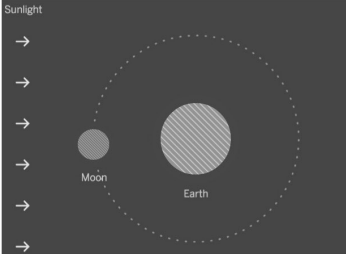
Which of the following models is correctly drawn?
¿Cuál de los siguientes modelos está correctamente dibujado?
B 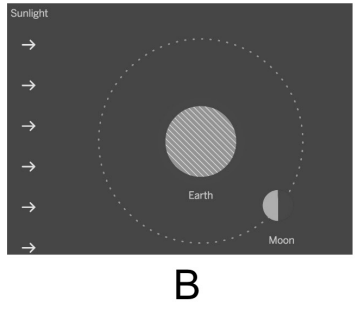
Which vocabulary word best matches this definition: the nearly circular path a smaller object (like the moon) travels around a larger object (light the Earth)
Qué palabra de vocabulario se ajusta mejor a esta definición: la trayectoria casi circular que un objeto más pequeño (como la luna) recorre alrededor de un objeto más grande (iluminar la Tierra)
Orbit /
orbita
Draw the top view of the sun, earth and moon. Make sure to label each, draw the moon's orbit, and shade in the correct portion of the dark side of the moon.
Dibuja la vista superior del sol, la tierra y la luna. Asegúrate de etiquetar cada uno, dibujar la órbita de la luna y sombrear la parte correcta del lado oscuro de la luna.
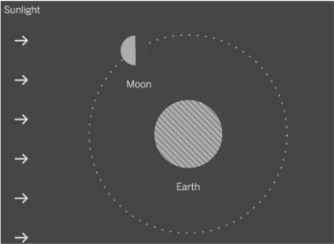
After a full moon, why does the moon's light look like it's getting smaller? (Hint: What is the moon doing that causes different moon phases on Earth?)
Después de la luna llena, ¿por qué parece que la luz de la luna se hace más pequeña? (Pista: ¿Qué está haciendo la luna que causa diferentes fases lunares en la Tierra?)
The moon moves so that we are able to see less of the half that faces the sun
La luna se mueve para que podamos ver menos de la mitad que mira hacia el sol
Does this diagram ALWAYS show a lunar eclipse? Explain why or why not.
¿Este diagrama SIEMPRE muestra un eclipse lunar? Explica por qué o por qué no.
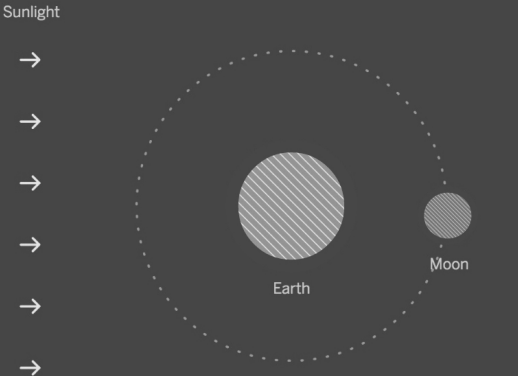
No it does not. Most of the time this diagram shows a full moon. In order for a lunar eclipse to occur the sun, the Earth, and the moon need to be aligned. This is because the moon's orbit is tilted so the sun, Earth, and moon don't always align.
No, no lo hace. La mayoría de las veces este diagrama muestra una luna llena. Para que ocurra un eclipse lunar, el sol, la tierra y la luna deben estar alineados. Esto se debe a que la órbita de la luna está inclinada, por lo que el sol, la Tierra y la luna no siempre se alinean.
When we draw a top view model of both a full moon and a lunar eclipse, it looks like the model below. What is the difference between the two?
Cuando dibujamos un modelo de vista superior de una luna llena y un eclipse lunar, se ve como el modelo de abajo. ¿Cuál es la diferencia entre los dos?
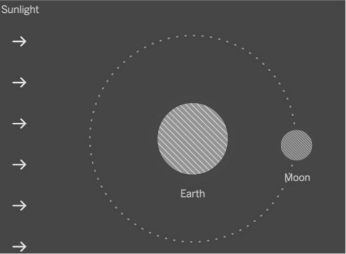
A full moon occurs more often. When there is a full moon, on Earth we see the moon as fully bright.
A lunar eclipse doesn't occur so often because of the moon's tilted orbit. When the sun Earth and moon align, we see a lunar eclipse. When there is a lunar eclipse the moon looks dark.
La luna llena ocurre con más frecuencia. Cuando hay luna llena, en la Tierra vemos la luna completamente brillante.
Un eclipse lunar no ocurre con tanta frecuencia debido a la órbita inclinada de la luna. Cuando el sol, la Tierra y la luna se alinean, vemos un eclipse lunar. Cuando hay un eclipse lunar, la luna se ve oscura.
Give me the definition of a model in science.
Dame la definición de un modelo en ciencia.
an object, diagram, or computer program that helps us understand something by making it simpler or easier to see
un objeto, diagrama o programa de computadora que nos ayuda a entender algo haciéndolo más simple o más fácil de ver
Which of the following is the correct diagram of what the moon looks like from above (top view)?
¿Cuál de los siguientes es el diagrama correcto de cómo se ve la luna desde arriba (vista superior)?

C
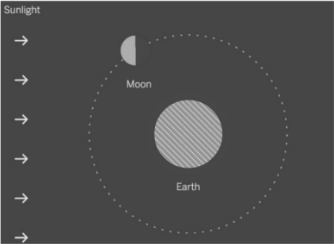
Why does the moon's light look like it is getting larger?
¿Por qué parece que la luz de la luna se hace más grande?
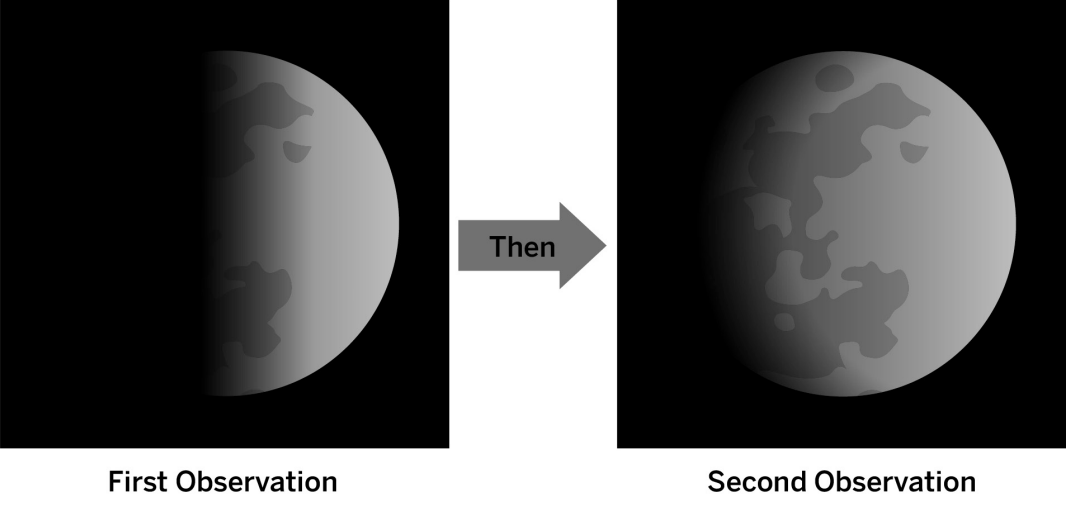
the Moon moved so that we're able to see more of the half that faces the sun
la Luna se movió para que podamos ver más de la mitad que mira hacia el sol
Which of the following top views could the half of the Moon that faces Earth ever be completely dark?
¿Cuál de las siguientes vistas superiores podría estar completamente oscura la mitad de la Luna que mira hacia la Tierra?

Always in Diagram 3, but sometimes in Diagram 2
Siempre en el Diagrama 3, pero a veces en el Diagrama 2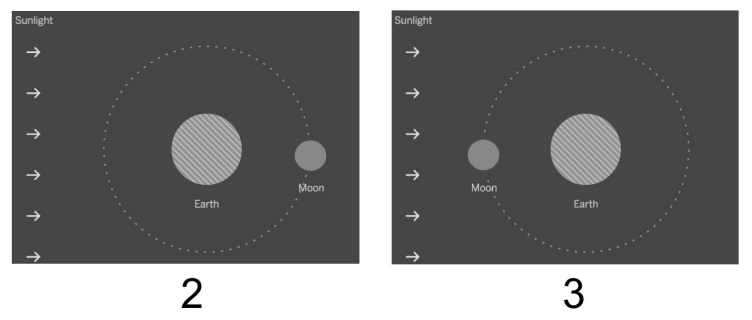
Draw a top view model of a full moon.
Dibuja un modelo de vista superior de una luna llena.
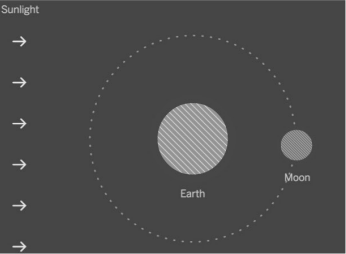
Write or draw 1 thing that you remember about lunar eclipses from this unit.
Escribe o dibuja 1 cosa que recuerdes sobre los eclipses lunares de esta unidad.
Answers will vary.
Lunar eclipse only happens when there is a full moon and the sun Earth and moon align.
Las respuestas variarán.
El eclipse lunar solo ocurre cuando hay luna llena y el sol, la Tierra y la luna se alinean.